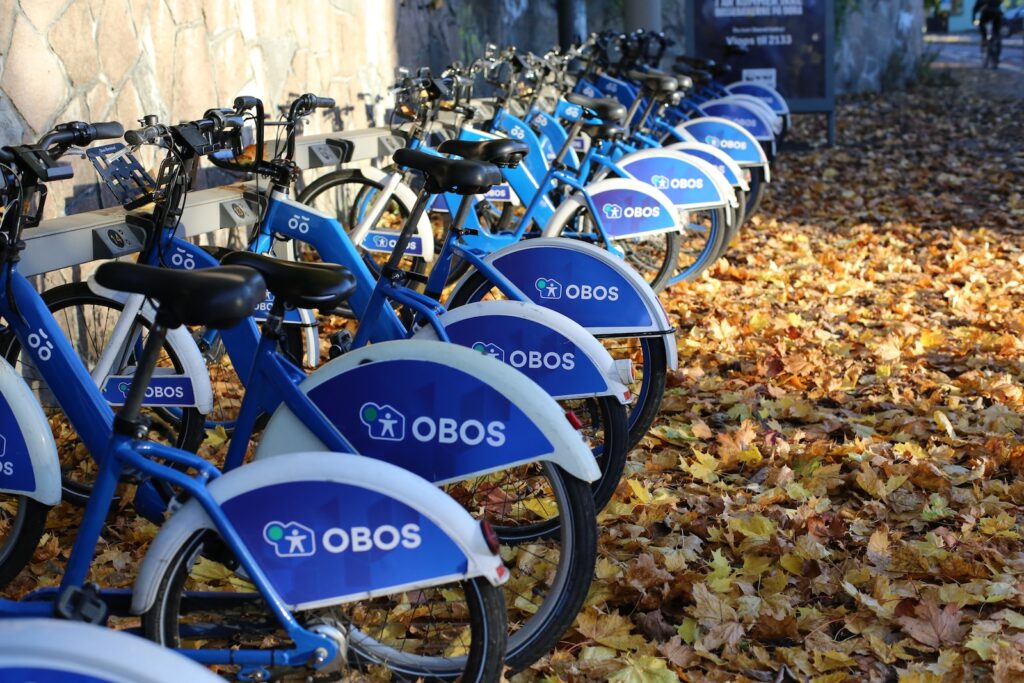The rise of bike sharing programs can be attributed to the growing awareness of the need for sustainable transportation options. One of the significant benefits of bike sharing is that these programs offer a flexible and accessible means of travel, allowing users to easily pick up and drop off bikes at designated stations. With the integration of technology, users can conveniently locate and unlock bikes using mobile apps.
Additionally, bike sharing not only reduces traffic congestion but also promotes a healthier lifestyle by encouraging physical activity. As a result, cities around the world are embracing bike sharing as a practical and sustainable solution for urban mobility.
Table of Contents
The City’s New Ride: Introducing Bike Sharing
As urban areas continue to grow, the need for sustainable and efficient transportation solutions becomes increasingly important. One of the most popular solutions in recent years has been bike sharing. Bike-sharing programs have been popping up in cities around the world, providing a convenient and affordable way for commuters to get around.
A Glimpse into the World of Shared Mobility
Bike sharing is a type of shared mobility, which refers to any transportation service that is shared among multiple users. Shared mobility includes services such as car sharing, ride sharing, and bike sharing. Bike-sharing programs typically involve a fleet of bicycles that are available for rent at various locations throughout the city. Users can rent a bike for a short period, usually by using a mobile app or a smart card, and then return it to any of the designated bike stations.

Bike sharing has become increasingly popular in recent years due to its many benefits. It provides a convenient and affordable way for commuters to get around, while also reducing traffic congestion and air pollution. Bike sharing also promotes a healthier lifestyle by encouraging people to get more exercise and spend more time outdoors.
From Cars to Bikes: The Shift in Urban Transportation
The popularity of bike sharing is part of a larger trend towards more sustainable and efficient forms of urban transportation. As cities continue to grow, traditional modes of transportation such as cars and buses are becoming less practical. Traffic congestion and air pollution are major concerns, and many cities are looking for alternatives.
Bike sharing is an attractive solution because it is relatively inexpensive to implement and can be scaled up or down as needed. It also provides a convenient and flexible option for commuters who may not want to rely on public transportation or own their bike.
Furthermore, bike sharing reduces the demand for parking spaces and alleviates the strain on existing transportation infrastructure. With dedicated bike lanes and bike-friendly policies, cities can create a safer and more accessible environment for cyclists. This not only benefits the individuals who choose to bike, but also the overall community by reducing traffic congestion and improving air quality. The success of bike sharing initiatives in various cities around the world demonstrates the potential for this mode of transportation to transform urban landscapes and contribute to a more sustainable future.
Financial and Economic Perks

Bike sharing has become a popular mode of transportation for urban commuters due to its numerous benefits. One of the most significant advantages of bike sharing is its financial and economic perks. In this section, I will discuss some of the financial and economic benefits of bike sharing.
Save Those Bucks: The Cost-Effective Charm of Bike Sharing
Bike sharing is a cost-effective solution for urban commuters. According to the National Association of City Transportation Officials (NACTO), on average, the typical bike share annual or monthly pass-holder rides for 11-12 minutes, covering a distance of 1-1.5 miles. These short trips play a crucial role in urban transportation.
The National Household Travel Survey reveals that 35% of all U.S. car trips span less than 2 miles. By building or supporting robust shared micromobility options, cities can enable individuals to undertake these brief journeys without resorting to personal cars or taxis, which exacerbate congestion and contribute to climate change. These short shared micromobility trips also synergize with transit services, expanding the number of individuals who can be conveniently served by each transit station and offering transit riders alternatives to avoid transfers or overcrowding.
When it comes to pricing, dockless e-bike systems witnessed a rise throughout the year. In 2019, the costs for users shifted from a consistent rate of $0.15 per minute to a range of $0.15 to $0.39 per minute, on top of the standard $1.00 unlocking fee, varying by the provider. This means an average 12-minute e-bike share trip would cost between $2.80 and $4.70, depending on the system.
Micro Mobility and the Sharing Economy
Bike sharing is also part of the sharing economy, which is a growing trend in the United States. The sharing economy is a system in which individuals can share resources, such as cars, bikes, and homes, with others. Bike sharing is an excellent example of micromobility, which is a mode of transportation that uses small, lightweight vehicles, such as bikes and scooters. By using bike sharing, users can contribute to the sharing economy and reduce their carbon footprint.
Boosting Local Economies: Small Businesses Benefit Too
Bike sharing can also contribute to the local economy by connecting people to employment, retail, and other places where economic activity takes place. The strategic placement of bike stations near local shops and eateries encourages increased footfall, as commuters and tourists alike can easily access these establishments. Not only does this foster a more vibrant street life, but it also translates to higher sales and visibility for small businesses.
Additionally, the transient nature of bike sharing means that riders are often exploring new neighborhoods or routes, leading them to discover and patronize small businesses they might not have encountered otherwise. By facilitating convenient and eco-friendly mobility, bike sharing inadvertently promotes local commerce, making it an invaluable asset for both consumers and small business owners.

As a frequent urban commuter, I know the importance of convenience when it comes to transportation. Bike-sharing services offer a convenient solution for urban mobility, with easy access to bikes, docking stations, and mobile apps that make it easy to find and rent a bike. Here are a few ways bike-sharing services offer convenience for urban commuters:
Spontaneous Commutes: Grab, Ride, and Go!
Bike-sharing services offer a convenient way to make spontaneous trips around the city. With bikes stationed at convenient locations throughout the city, you can easily grab a bike and go without worrying about parking or waiting for public transit. This is especially useful for short trips, where taking a bus or driving would be more time-consuming.
No More Parking Blues: Convenient Docking Stations and Beyond
One of the biggest challenges of urban commuting is finding a place to park. With bike-sharing services, you don’t have to worry about parking your bike. Simply return it to a convenient docking station when you’re done. Some bike-sharing services even offer “virtual docking stations” that allow you to park your bike anywhere within a designated area, making it even more convenient to use.
Reducing Traffic Congestion
Urban traffic congestion is a major problem in many cities around the world. Bike-sharing services offer a solution to this problem by providing an alternative to driving. By using a bike-sharing service, you can avoid traffic jams and reduce congestion on the roads. This not only benefits bike riders but also drivers who have to deal with congested roads.
Environmental Impact of Bike Sharing

Bike sharing is not only a convenient way to commute but also an eco-friendly transportation option. Let’s take a closer look at the environmental benefits of bike sharing.
Cutting Down Carbon: The Eco-Friendly Commute
Bike sharing reduces carbon emissions and helps to reduce the negative impact of transportation on the environment. According to a study by Better Bike Share, bike-share systems have the potential to reduce carbon emissions significantly. Although bike share systems’ overall impact on carbon emissions is relatively small compared to other modes of transportation, they can still make a significant difference in reducing emissions in congested urban areas.
Reducing Air Pollution
Bike sharing also helps to reduce air pollution, which is a significant environmental problem in many urban areas. A study conducted on the environmental impact of bike sharing found that bike-sharing systems have a positive impact on air quality. Bike sharing reduces the number of cars on the road, which means that there is less traffic congestion and less air pollution.
Promoting Eco-Friendly Transportation
Bike sharing promotes eco-friendly transportation and encourages people to use alternative modes of transportation instead of driving their cars. According to a study, bike-sharing programs are associated with various social, environmental, and economic benefits, such as a decrease in carbon dioxide emissions, a reduction in various diseases, and a decline in traffic congestion and noise pollution.
Safety and Regulation in Bike Sharing
As with any form of transportation, safety is a top priority for bike-sharing programs. To ensure the safety of riders, bike-sharing companies have implemented a variety of safety measures.
Safety Measures and Helmet Use
One of the most important safety measures in bike sharing is the use of helmets. Many bike-sharing programs require riders to wear helmets while using their bikes. Some programs even provide helmets for riders to use free of charge. Riders need to wear helmets because they can help prevent head injuries in the event of an accident.
In addition to helmets, bike-sharing companies also implement other safety measures, such as regular maintenance checks on their bikes to ensure they are in good working condition. Some programs also have safety features built into their bikes, such as lights and reflectors, to make them more visible to motorists and pedestrians.
Vandalism and Regulation
Another important aspect of bike sharing is regulation and preventing vandalism. To prevent vandalism, bike-sharing companies often have strict rules about how their bikes can be used and where they can be parked. For example, some programs require riders to park their bikes at designated bike racks or docking stations, while others allow riders to park their bikes anywhere as long as they are not blocking pedestrian walkways or obstructing traffic.
Additionally, many bike-sharing programs use GPS tracking technology to monitor the location of their bikes and ensure that they are not being stolen or misused. This technology can also be used to track down bikes that have been vandalized or stolen.
Bike Sharing Around the World
Bike sharing has become a popular mode of transportation for urban commuters around the world. It offers a convenient, affordable, and sustainable way to travel short distances within a city. Bike-sharing programs have been implemented in many cities across the globe, and they continue to grow in popularity.
Bike Sharing in North America
In North America, bike sharing has gained popularity in recent years. The National Association of City Transportation Officials (NACTO) reported that there were over 40,000 shared bikes in North America in 2017. The United States is one of the leading countries in bike sharing, with many cities offering bike-sharing programs. Washington, D.C., for example, has the Capital Bikeshare program, which has over 4,000 bikes and 500 stations. Seattle also has a bike-sharing program, which is operated by Pronto Cycle Share.
Bike Sharing in Europe
Europe has a long history of cycling culture, and bike sharing has been embraced by many cities in the region. The first large-scale bike-sharing program was launched in Copenhagen in 1995, and since then, many other cities have followed suit. Montreal’s Bixi program is one of the largest bike-sharing programs in North America, with over 6,000 bikes and 540 stations.
Bike Sharing in Asia
Bike sharing has exploded in popularity in Asia, with many cities adopting the technology. China is the largest market for bike sharing, with over 16 million shared bikes in operation. Mobike, one of the largest bike-sharing companies in China, has expanded to other countries in Asia, including Singapore and Japan. E-bikes, or electric bikes, have also become popular in Asia, with many bike-sharing programs offering them as an option.
FAQ
What are the pros and cons of bike-sharing?
Pros: Bike-sharing promotes eco-friendly transportation, reduces traffic congestion, offers cost-effective commuting, and encourages physical activity.
Cons: Potential for vandalism or theft, limited availability during peak times, and the need for users to locate docking stations can be inconvenient.
Is bike-sharing good for the Environment?
Yes, bike-sharing reduces carbon emissions by replacing car trips, decreases traffic congestion, and promotes a cleaner urban environment.
Are bike share programs successful?
Generally, yes. Many cities globally report increased ridership, reduced traffic congestion, and positive economic impacts from bike-sharing programs.
What are the challenges of bike-sharing?
Challenges include maintaining and rebalancing the fleet, addressing vandalism and theft, ensuring rider safety, and overcoming infrastructure limitations in some cities.








